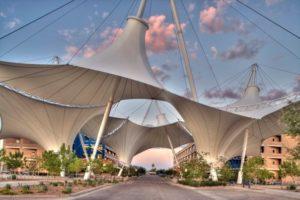By Recker McDowell
Scottsdale is considering the vision and future of its popular Old Town area. Tempe is looking at building more urban and creative neighborhoods. Other cities — including Phoenix, Chandler, Goodyear, Mesa and Gilbert — are all looking to take their downtowns to the next level including more residents, offices and restaurants.
Communities, in particular Scottsdale, are also looking at how designs, architecture and new developments fit into their downtowns and key neighborhoods.
That is putting a significant focus on design plans that include shade, solar and sustainability. The three S’s also show a path for improve the quality of architecture throughout the region.
We all know the need for shade in Arizona and the glaring lack thereof in many past developments.
Shade structures, canopies and trees and can better connect downtown and other areas. Better connectivity translates into better walkability which has long been a challenge in the sprawling and auto oriented Valley.
Scottsdale and other cities will also continue to look for more solar and sustainability from developers and their architects for new projects and redevelopments.
Arizona is one of the top states for solar in the U.S. (along with California). We all know we should be number one considering our climate and preponderance of sunny days.
Forward thinking cities should expect more solar and sustainability in development designs. And sustainability efforts should be significant and tailored more connected living in the Sonoran Desert. There is architecture and designs, including the ASU SkySong development at Scottsdale and McDowell roads, that can serve as a model for other projects.
There are, of course, costs, zoning and bottom-line considerations for what developers and builders can do with projects whether they are in downtown business and entertainment districts or suburban office park.
Scottsdale, Tempe, Phoenix and other cities have a chance to flip the script on past characterizations of the Valley as sprawling and not sustainable.
We can do this through more connected designs and best architectural practices.
City planners and elected officials should also reward and me more open to higher-quality architecture and designs — especially those that invest in shade, solar and sustainability.
Those will help enhance and better connect downtowns and areas driving economic development as cities ponder their futures.

